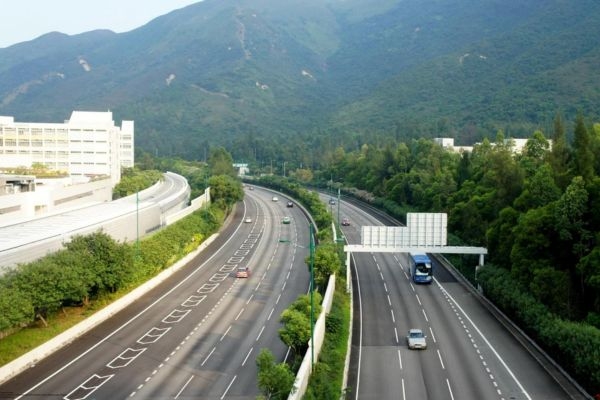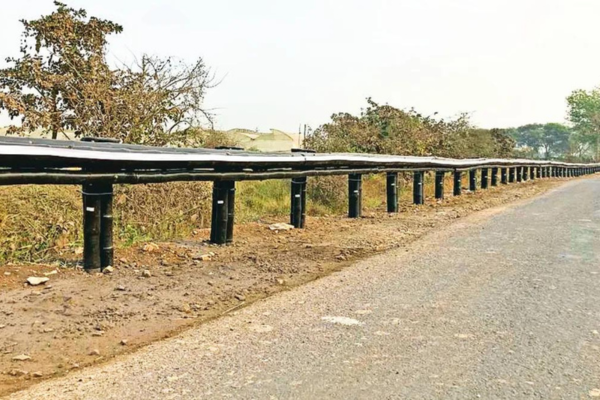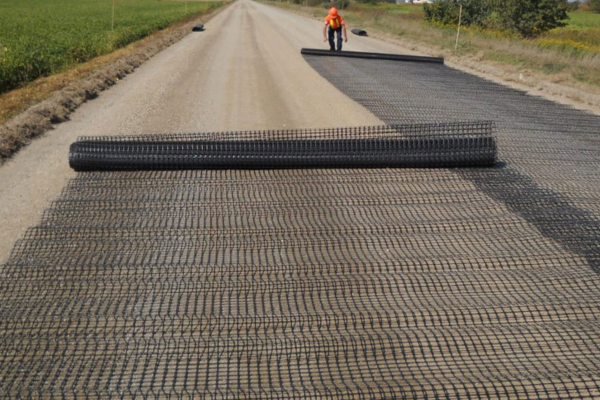ONLY THE SUSTAINABLE IS HERE TO STAY
Road construction can prove pretty disruptive if the norms are not complied with.
Total Views |
Undoubtedly, the road and rail infrastructure provide the basis for economic development of a country. But at the same time, we realise today that we can no longer turn a blind eye to the severe environmental impact as more and more highways get constructed through mountains and forest cover. While we cannot really hold down the much needed ask for the network of land connectivity, we need to stop and take a look at how we can work to mitigate the consequences with the help of technology and innovative solutions.

Ground reality
Talking from my expertise particularly in the road construction sector, the conventional technologies used presently in most projects demand high amounts of energy and tend to create environmental pollution in terms of noise, emission and air and also pose possible health hazards to workers. Road construction can prove pretty disruptive if the norms are not complied with. There are considerations made when ecosystems are altered, wildlife is affected, trees are felled, construction materials are mined and waste materials are disposed of in the environment. Infrastructure and buildings make up the framework of our society, but did you know that buildings are responsible for 39% of the world’s carbon emissions, according to research findings from the World Green Building Council? More insightful data shows that the majority (~28%) is caused by operational carbon emanating from lighting, heating, ventilation and air conditioning and electricity use from commercial buildings currently accounts for ~18% of all greenhouse gas emissions. And although there are stringent riders like Environmental clearances mandated for all these, the impact hits the environment at the end of it all.
On one side, we need roads for our overall development, but on the other side, we also require clear air and water, which originate from the same areas undergoing a drastic change in environment. To continue availing both the benefits, we need to ensure that a fair amount of balance is maintained. This is where the need for innovation comes in- something that will not just reduce the disruptive activities but also repurpose, reuse and recycle what we have discarded and are dumping it in landfills or open fields for natural degradation. Such green and smart technologies are the need of the times.
Hope for the future
There is ample research going on in our country already. Highly sophisticated laboratories, and qualified and experienced scientists are deeply invested in evolving green solutions. The catch however is that in the midst of classical research, the focus on its commercial viability is lost. The researchers need to constantly bear in mind that these green solutions should be sustainable, environment-friendly, economical and at the same time, they should be ‘practical’ as well. They should lay emphasis on criteria like optimum utilisation of locally available material and the expertise of human resources that will apply it. Green road approach with bio-bitumen, reuse of milled material, appropriate soil engineering techniques, eco-friendly manufacturing of noise-reducing asphalt and bamboo crash barriers are some of the innovative technologies that are now being talked about in the road construction circles in India.
What was once a sycophancy concept of Sustainable development is now in its way to transformative development that aims at incorporating a multitude of options, measures and actions followed by regulations in today’s corporate scenario. With every industrial sector now notching up its awareness levels and plans of action, green technology has gained massive attention owing to rising concerns about environmental sustainability. More so, as forums like the G20 Summit in 2023 lay a clear emphasis on issues like climate change, sustainable development, energy, and environment, and all interrelated issues. The CII (Confederation of Indian Industries) has also recently taken up the agenda of sustainable solutions in the road construction sector. As a committed member of the CII for this forum, we are already proposing and promoting some tried and tested solutions and the innovative efforts of enterprising entrepreneurs, who have worked on the commercial viability to enhance their usage. The reason for the sudden surge in such movements at these global levels is with the sole intent to provide the needs of the present, and to protect and preserve without compromising, the requirements of future generations.
Today almost every organisation lays an emphatic accent on sustainability. They are eager to switch to decarbonized, decentralised and digitised sources of energy. From banning polystyrene plates and glasses in canteens to using motion dependent LEDs or solar energy for lighting, from disposing industrial waste to conversion of bio waste to compost, sincere environmentally friendly activities and compliances have become the new age mantra. Renewable sources like wind and solar energy are gaining acceptance due to their dependability as well as availability round the clock, while reducing power grid demand and carbon emissions drastically.
Such small yet significant efforts will contribute as decisive enablers in India’s journey towards reaching the 2030 Sustainable Development Goals (SDGs). More and more organisations are taking cognizance of this need of the times and are opening up to considering and embracing solutions that will lead to achieving their environmental, social and governance (ESG) goals.
Smart solution for the smart age
Just as energy optimisation is an important agenda, creating cleaner fuels through processes that reduce emissions are just as integral to sustainable development. Similarly, exploring viable options for plastic circularity now engage technologies for plastic waste management and are offering road constructors newer options in construction materials. So these are a few techno savvy green solutions that are gaining momentum-

(Bamboo crash barriers)
1. Bamboo crash barriers
- Manufacturing location: Assam/ Chhattisgarh.
- Capacity: Equipped to produce 500 Km of Bamboo Crash Barrier per annum.
- Standards: Workmanship of the bamboo crash barriers complies with the common EU standard “EN 1317-2 – containment level H2”. Also tested by NABL labs, as per IRC standards. The National Automotive Test Tracks (NATRAX) in Pithampur, Indore has rated this product as Class 1 during the Fire Rating Test conducted at the Central Building Research Institute (CBRI) in Roorkee. Has been earlier test-installed in an NHAI project. Rajpath has also recently received approval for its application in their ADB project.
- Product description: Specially treated with HDPE, and uses vacuum pressure impregnation (VPI) process to make this composite material out of a select species of bamboo.
- USP: Why opt for this?
- The Bamboo's hollow circular structure with robust internodes gives it the strength and flexibility and ensures that it swiftly regains its original shape after a vehicle impact.
- This not only enhances safety for vehicle occupants but also minimises damage to the vehicle itself.
- Highly resistant to weather and fire, heat, rains as well as insect infestation. It is hence practically maintenance-free.
2. Bio-LDO (Plastic Oil)
- Manufacturing Unit: Maharashtra
- Capacity: Can process more than 3000 tons of plastic waste per year.
- Standards: Have EPR and MPCB Certification
- USP: Why opt for this?
- Can be blended with upto 50% Light Diesel Oil/LDO
- Lowest level plastic including single use plastic gets end of life and this happens with emissions as per MPCB permissible limits
- Bio- LDO (Plastic Oil) is an alternative to fossil fuel as an import substitute for India, saving foreign reserves for India.

(GTIGX Triaxial Geogrid)
3. GTIGX Triaxial Geogrid
- Manufacturing Unit: Himachal Pradesh.
- Capacity: upto 30,000 SQM per day
- Standards: IS 16014, IS 16014:2018 & International norms such as ASTM and EN.
- Product description: Available with Zn coating and Zn +PVC coating. Everything is done inhouse right from chemical analysis of incoming steel wire rods, Zinc ingots and PVC granules to the manufacturing and final QC of the finished product.
- USP: Why opt for this?
- Wide range of applications in ground engineering, slope stabilisation, erosion control, rockfall stabilisation and rehabilitation works in the sectors of Road construction, agriculture, industry, agriculture, defence, water resources as well as hydroelectric power plants to name a few.
- A wide variety of forms, shapes, available to suit application, requirement and locations/ project kind.
- Completely customizable at economically viable costs.

(Road constructed from Plastic and Bitumen)
4. Addition of plastic to Bitumen for Road construction
- Manufacturing Unit: Maharashtra
- Capacity: Can supply to suit requirement
- Standards: IRC accredited
- Product description: 8% of *ReRouteTM can be added to Bitumen. Drum mix type hot mix plant of capacity 60MT/hour can be utilised for mixing bituminous premix concrete at specified required temperature. Special modifications may be required to the metal conveyor belt for adding shredded plastic to the hot mixing drum along with stone metal. The Drum temperature to be maintained between 160°C - 170°C to ensure melting of shredded plastic. Hot mix material then transported to site for laying. Temperature of mix to be maintained in between 120°C - 140°C.
- USP: Why opt for this?
- Estimated percentage of saving on cost of bitumen: 3.51%
- ReRoute™ enhances the durability of roads, reduces water ingress, decreases stripping and pothole formation thereby reducing the overall maintenance cost occurring due to frequent maintenance related repairs.
- End life Hard to Recycle waste plastic is converted into useful products for Construction of Roads.
The national shift to clean and green technologies is now more significant than ever. The increasing energy demand, coupled with the depleting supply of fossil fuels and the urgency to lessen carbon emissions, has led to catapulting interest in alternative energy sources, energy-efficient and recycled applications for sustainability. With the rapid evolution of green technological innovation and their trials as well as adoption is paving the way for a future filled with hope. To reach effective and impactful environmental standards and achieve strong sustainable economic development, we must promote, propel and invest extensively in green technologies.
About the Author
Mr. Jagdish Kadam is the techno savvy CMD of Rajpath Infracon Pvt. Ltd., a 35 years young infrastructure organisation that proudly boasts of an India Book of records in 2021 followed by a Guinness World record in 2022. He has been a speaker on the globally acclaimed TEDx platform and a recipient of the multiple prestigious honours and special Excellence Awards by Ministry of Road Transport and Highways (MoRTH) and NHAI on various occasions, recognized and honoured by the ET, CNBC, Asia one as the Best Brand and Best Leader in Dubai, and has been felicitated by the COEP Alumni with the Abhiman Award.
Besides this he also shoulders the responsibility as the Chief Trustee of the Raja Shivchhatrapati Pratishthan, Pune of the famed Shivshrusti Project, Trustee of Deccan Education Society, President of the Rajshree Kadam Prathisthan and the Executive Board member of the FLAME University, Pune.
With a civil engineering degree and a wealth of experience up his sleeve, Mr. Kadam is passionate about driving innovative ideas and implementing them. For this insightful vision and sharp evaluation in this regard, he has been nominated to the Board of the CII for propelling the agenda of Sustainability in the road construction sector.

